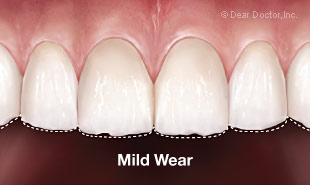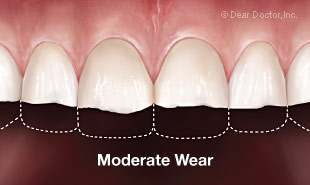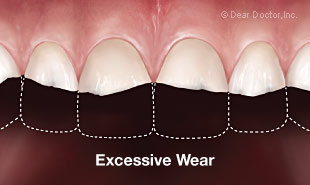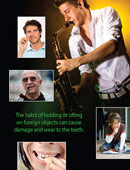How And Why Teeth Wear
Understanding The Basics Of How Your Bite Works
(Continued)
Teeth are unusual in that the enamel, or the covering layer of the crowns of the teeth, is non-living.
Body Wear, Tooth Wear — Beneath The Surface
Most bodily tissues, including hard tissues like bone are continually going through cycles, being built up and broken down. These cycles consist of anabolism — a building up or growth phase (“ana” – upward), while the breakdown phase is called catabolism (“kata” – downward). During growth, from childhood to adulthood, tissue growth exceeds breakdown, until a balance is reached at maturity when growth is complete. Thereafter the balance changes and as one ages, breakdown exceeds building as we inevitably age. All too often the manifestation of age is wear.
Teeth are unusual in that the enamel, the covering layer of the crowns of the teeth, is non-living. The cells that initially give rise to the enamel in early life subsequently perform other functions. Interestingly, enamel is the hardest substance produced in the animal world; it is highly mineralized and crystalline in structure composed mainly of calcium and phosphate, and it is relatively resistant to chemical attack and to wear. The dentin underlying the enamel has a more bone-like quality; it is living, and nourished by the tissues of the pulp that is housed in the central chamber of the tooth (the root canal). As teeth age, more dentin is created from within the tooth. This is one of the reasons why teeth change color with age; they become less white, and less sensitive to temperature.
 |
| Early or mild wear is characterized by thinning and loss of the enamel surfaces usually resulting in chipping and fracturing of the incisal (cutting) edges, shown here affecting the upper front teeth. |
 |
| Moderate wear showing significant shortening of the upper front teeth, resulting in loss of facial height with a consequent characteristic appearance of aging. |
 |
| Excessive tooth wear resulting in advanced loss of tooth structure, which further accentuates loss of facial height and aging. Large areas of softer dentin are also exposed, increasing the potential for accelerated tooth wear. Note that wear also affects the back teeth — decreasing facial height, and accentuating the aging process. |
What Is “Normal” Wear?
Wear of the teeth that is most visible is occlusal wear that affects the biting (enamel) surfaces. It occurs when enamel surfaces interact between the upper and lower teeth. More specifically, wear results in the removal of material from the enamel surfaces. Contact due to motion is an important distinction between mechanical wear and other processes that can have similar results, as we will cover later. And it is not only the teeth that can suffer, but other structures can also bear the brunt of excessive force within the oral system.
Because there are no clear guidelines for what constitutes “normal” wear, it is generally and broadly defined: normal wear should be equal in rate or speed with aging. It is common for the teeth to show some wear with age, but the system will naturally compensate for it. As teeth wear they will move minutely, by erupting slightly, moving to maintain proper biting relations. They will also move or drift toward the front of the mouth and tend to crowd more with age. The process is not exactly glacial, but it does take a very long time. It is when wear becomes excessive, beyond what the body can compensate for through the natural eruption of teeth, that problems arise leading to changes in bite relationships and loss of facial height.
May The Force Be With You
Normal forces are applied to the teeth, during both biting and non-biting contact. Biting and chewing normally generate forces of between 13 – 23 pounds. During non-biting contact the teeth come together fleetingly hundreds, if not thousands of times a day at a force of 0.75 – 7.5 pounds. These brief contacts provide the stimulation that is necessary to maintain normal healthy bone.
 |
| The habit of holding or biting on foreign objects can cause damage and wear to the teeth. Click to enlarge |
Paranormal force or parafunctional forces, by definition are outside the normal range. Now here's where it gets interesting. The average human has the potential to generate a biting force of anywhere between 23 – 230 pounds. It's not just the large forces generated, but their direction, duration and frequency together that are so damaging. Highly destabilizing forces applied both frequently and for long periods can lead to problems, symptoms and breakdown. Parafunctional forces and habits are generated most often through clenching, and/or grinding (also known as bruxism). They can affect one or many elements of the oral system.
They can stress:
- The muscles — causing spasm and pain;
- The jaw joints — causing TMD (Temporo-Mandibular Disorder)
- The periodontal ligaments (attach teeth to bone) — causing tooth looseness or;
- The teeth — causing excessive wear or even fractures.
Combinations of some or all of these factors can also occur. Excessive wear is also known as retrograde wear — wear that is faster than the normal rate. It cannot be readily maintained by the normal compensation of tooth eruption and the effects can be profound. However, even excessive wear may not cause symptoms. Still other factors can increase wear, like decay that compromises the teeth and filling materials, either too soft which will wear too quickly, or too hard, which will cause undue wear of opposing teeth.




